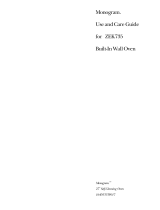Timed Cooking
Wall Oven
16
How to
set the
oven for
a delayed
start and
automatic
stop
You can set the oven to delay the start of
cooking, cook for a selected length of time
and turn off automatically.
NOTE: Before beginning make sure the clock
shows the correct time of day.
To avoid possible burns, place the shelves
in the correct position before you turn the
oven on.
1 Turn the mode selector knob to TIMED.
2 Turn the oven control knob to the desired
function (BAKE, CONV. BAKE or CONV.
ROAST).
3 Using the temperature control knob,
set the desired temperature.
4 Press the START TIME button.
5 Press the increase “▲” or decrease “▼”
button to set the time of day you want the
oven to turn on and start cooking.
If the increase “▲” or decrease “▼” button is
not pressed within 5 seconds of pressing the
START TIME button you will need to press
START TIME again.
6 Press the COOK TIME button.
7 Press the increase “▲” or decrease “▼”
button to set the cooking time. (The
maximum cooking time is 11 hours and
50 minutes. The minimum cooking time
is 1 minute.)
If the increase “▲” or decrease “▼” button is
not pressed within 5 seconds of pressing the
COOK TIME button you will need to press
COOK TIME again.
NOTE: The oven ON & PREHEAT lights and the
oven interior lights will not turn on until the oven
starts heating.
The display will return to the time of day and
show the word DELAY. When the start time is
reached, the display will show the word COOK
and the cooking time countdown.
At this time the oven ON light and the oven
interior lights turn on and remain on until the
end of timed cooking.
The oven will continue to cook for the
programmed amount of time then turn off
automatically.
8 At the end of timed cooking the word
COOK will blink in the display and an end
of cycle tone will sound. To clear the end of
cycle tone press any button. Turn the oven
control knob to OFF and the mode selector
knob to MANUAL.
NOTE:
• You will hear a convection fan while cooking
with convection features.
• A cooling fan will turn on to cool internal
parts. This is normal, and the fan may
continue to run even after the oven is
turned off.
• The low temperature zone of this oven
(between 150°F. and 200°F.) is available to
keep hot cooked foods warm. Food kept in
the oven longer than two hours at these low
temperatures may not be safe to eat.
• Foods that spoil easily, such as milk, eggs,
fish, stuffings, poultry and pork, should not
be allowed to sit for more than one hour
before or after cooking. Room temperature
promotes the growth of harmful bacteria. Be
sure the oven light is off because heat from
the bulb will speed harmful bacteria growth.
NOTE: On double oven models, you will
not be able to set a timed cooking or
cleaning function in both ovens at the
same time.




















